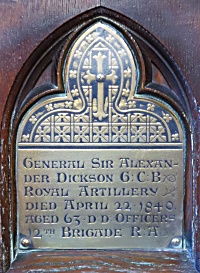The plaque is on the back of one of the choristers stalls in the chancel.
North side, back row, seventh from the west end.

DER DICKSON G.C.B.
ROYAL ARTILLERY
DIED APRIL 22 1840
AGE 63. DD: OFFICERS
12TH BRIGADE R.A.
Further Information
Major-General Dickson entered the Royal Artillery on 6th November 1794. It is not possible to do justice to the services of an officer who was pre-eminently the first artilleryman of his day, and one of the most distinguished of the many celebrated officers who served under the great Duke of Wellington.
As a Lieutenant he was present at the capture of Minorca in 1798, and at the blockade of Malta and surrender of Valetta in 1800. Here, as subsequently at Monte Video, he served as acting engineer.
As a Captain, he commanded his company at the seige and capture of Monte Video, and the attack on Buenos Ayres in 1807. He proceeded to Portugal in 1809, and served as Brigade-Major to the Royal Artillery under Colonel Howorth at the affair at Grigo, the capture of Oporto, and subsequent expulsion of Soult from Portugal in 1809. Shortly after this time he was given command of the Portuguese artillery, with the local rank of Lieut-Colonel, and by this arrangement Lord Wellington was enabled to overcome the technical difficulty arising from the regimental seniority of other officers, and to treat Dickson as virtual chief of his artillery.
He commanded the Portuguese artillery in the battle of Busaco, and at the Lines of Lisbon (Torres Vedras) in 1810, at the affair of Campo Mayor, the seige and capture of Olivenca, and the battle of Albuera in 1811.
He commanded the artillery operations in 1811, at the first and second seige of Badajoz, under Lord Wellington's immediate orders; also at the seige and capture of Cuidad Rodrigo, the seige and capture of Badajoz, the attack and capture of the forts of Almaraz, the seige and capture of the forts at Salamanca, and the seige of Burgos in 1812; and he commanded the reserve artillery of the army at the battle of Salamanca, and at the capture of Retiro, Madrid, in the same year. Colonel Sir W. Robe, who commanded the artillery of Lord Wellington's army, having been severely wounded at Burgos, was obliged to return home, and the chief command of the artillery was then conferred by Lord Wellington upon Dickson, who, by virtue of his rank in the Portuguese artillery, was the senior officer of that arm in the Allied army.
He commanded the Allied artillery at the battle of Vittoria, 1813; the seige and capture of San Sebastian, the passage of Bidassoa, battle of Nivelle, and battle of Nive in 1813; and at the passage of Adour and the battle of Toulouse in 1814.
The next campaign of Lieut-Colonel Dickson was the inglorious one of New Orleans in 1814-15. He commanded the artillery of the expeditionary force and was present in the attack on that place and at the capture of Fort Bowyer, Mobile.
Returning from America early in the year, he was present and engaged in the battles of Quatre Bras and Waterloo, and subsequently commanded the battering train with the Prussian Army at the seiges of Maubenge, Laudrecies, Phillippeville, Marienbourg and Rocroy, in July and August 1815.
Captain Dickson had been promoted to Brevet-Major and Brevet Lieutenant-Colonel in 1812, but almost incredible to relate, he received no further promotion until 1825, when he attained the same rank regimentally, and was also Aide-de-Camp to the King, with rank of Colonel in the army, on the 27th May in the same year.
In September 1822, he was appointed Inspector of Artillery, and Deputy-Adjutant-General, Royal Artillery, on 10th April 1827, in succession to Lieut-General Sir J MacLeod upon whose decease in January 1833, he was appointed Master-Gunner, St James Park.
In 1838 upon the death of Lieut-General Millar, he succeeded that officer as Director-General of Artillery (Field Train Department), which appointment was combined with that of Deputy-Adjutant-General during his life. Sir Alexander was also Commissioner of the Royal Military College, Sandhurst and Public Examiner at Addiscombe. He was created a Knight Commander of the Bath in January 1815, and on 28th June 1838 was made a Grand Cross of the same order. He was also a Knight Commander of the Guelphic Order (K.C.B.), and was in receipt of a good service pension of £365 per annum.
Sir Alexander had conferred upon him numerous medals and awards, but perhaps the most gratifying testimonial to his great merits was presented to him by his brother officers of the Royal Artillery (many of whom were his seniors in the regiment) in the shape of a handsome sabre on which was a suitable inscription.
Major-General Dickson died in London 22nd April 1840, aged 63 years, and was buried in Plumstead Churchyard with military honours.
[From the 1873 Guide to the Church]
Sir Alexander's Papers are held at the Royal Artillery Museum
See also
Wikipedia
